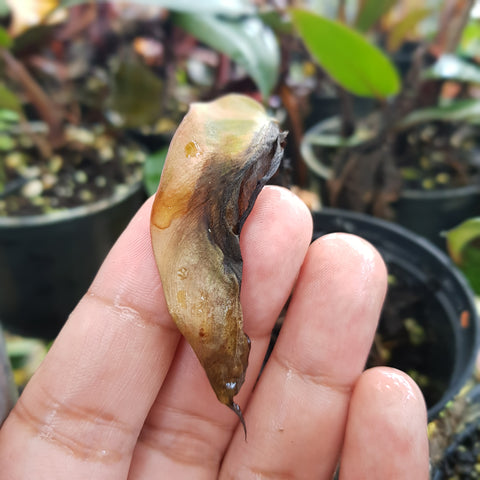
The Princess Diaries
Good day plant folks!
Let's talk about the royal family of the philodendron genus, the pink princess. It is said to be a mutation of the philodendron erubescens. Generally they are quite moderate-easy to care for. However with tissue-culture cultivars appearing in the market nowadays (like the ones in our store), it is good to actually give extra care and be more observant when caring for them. Here are a few reasons why:

(Pink princess lensed by @Sarah.synthesis)
1) They generally start small nowadays as most are tissue cultured.
Treat them like baby philodendrons or seedlings. Respect their demanding requirements. Give them the best indirect bright spot at your house. Make sure their pots are not too big for them. A well-draining soil mix is a must and they prefer scheduled watering. They are royalty and you must treat them like one, sing to them if you must.
2) They are super sensitive to humidity levels at that small stage
Since most are small, they do not do well in dry and windy areas. Best to bunch them up with your other plants. They do not like being out on their own. You can also get a humidifier to add moisture in the air to the area. Failure to fulfil these requirements will result in very unsightly wrinkling on their leaves. Every princess needs their entourage, so bunch them up!

(Wrinkled leaf)
3) They are also sensitive to the heat
They tend to not do well during heatwaves in Singapore. Months like April (my birthday month) are always hot and scorching. Even though they are kept in indirect bright light, they can still get affected by the heat. Move them to cooler areas during these hot months. Leaving them in the heatwave can also cause wrinkling on their leaves.

(Leaf burn from sun and heat)
4) They are quite sensitive to new environments
Even if you get the requirements right, they will need time to adjust. They might show some wrinkling, spots (we will discuss more on that later). These happen more to the smaller specimens. Usually it takes around 2 weeks to a month for them to get used to their new homes. Every princess needs time to feel at home in their new castle.

(Leaf unfurling back to normal, note the previous wrinkling leaf)
5) They have delicate leaves
Their tiny leaves are so so thin. For mist lovers, just stop. Put your finger away from the trigger and put down the spray bottle. They totally hate it. Having water on their leaves can cause leaf rot/mush. It is not a fun sight. Their leaves will totally shred and turn to goo. Unless you are into zombie pink princesses.

(Leaf rot from too much water on leaves)
6) Leaf spots
First thing you need to do is calm down. Philodendrons are susceptible to this particular bacterial infection. This usually happens when their immune system is compromised. These are few reasons what might have caused it:
- Aftermath of pest attack (particularly thrips and spider mites)
- Strong pesticides
- Compact or undesirable soil mix
- Continuous environmental stress (constant heat, wet etc)
Once you have ruled out the possible cause and fix it, there is nothing else you can do but let them heal on their own. You can give it plant vitamins (Superplant etc) to boost their health. The spots get lesser as new leaves grows. It will not spread unless the philodendrons around them are in undesirable conditions too. If they are, what are you waiting for? Go help the others!

(Bacterial spots)
7) Pink princess and their stalkers
They do get pests from time to time since they are so desirable. Most common ones are thrips and occasionally spider mites. These babies are also very sensitive to strong pesticides, so stick to gentle ones. You can use white oil or our neem insecticidal soap bars. The foam from the soap really gets into their sleeves and goes directly into the soil. Do a preventive spray or soap once a week or two. Every princess loves their spa days.
8) Refined taste
With all the pink specks and splashes, it is recommended to give them a strict diet of slow release fertilizers. Best applied once every 3-4 months or when all the granules have disappeared. Applying fast release fertilizer (bone meal, chicken or goat manure) might cause them having more greens than pinks on their leaves. They take their meals seriously!
9) Perfection isn't real
Not all pink princesses will look the same even if they were created in the same tissue culture batch. There are also some genetics that could be better, like the pink princess marble. However for some cases, they might be unstable as they get too much pink. So always ask the origin of your pink princesses. The variegation are sometimes random. If you are having too much green leaves, there could these 4 reasons why:
- Too much light. When placed in areas where sun is harsh or area is too hot, it results in the pink princess going all green. It is coping with the environment and it is trying its best to protect its leaves. The pink bits are very sensitive to harsh sun so they will stop producing it altogether. Green is its natural sunscreen.
- Too little light. When placed in an undesirable area where it is not getting sufficient light, it starts going all green too. This princess is a survivor, they will forego their beauty for survival.
- Too much food, if you are feeding your princess fast release(organic fertilizer) or high nitrogen based fertllizers, it might also result in more greens than pink. Slow release is still the most affordable and the best in my opinion. Too much of anything is never a good thing unless its love and positivity.
- Sleeping beauty. There are the rare instances when you have done it all right and they're still not showing their pinks. The variegation might have gone dormant. You might have to give it a snip in one of the nodes and this will trigger back the variegation. Do it only if your pink princess have attained a certain height or size. Even Rapunzel goes for a trim I'm sure.

(Pink princess finally showed pink after a trim, note the all green leaves before it)
They are a joy to grow once you get their requirements right. This guide above applies to their other royal family members too. The white princess, white knight and white wizard. They are all so beautiful but can be a royal pain in the...
Fendi

Martin
Thanks Fendi! Thanks for post. I will start on the troubleshooting journey right away!
Shumin
Such a nice and informative read! Keep posting on the plant blog, Fendi!!